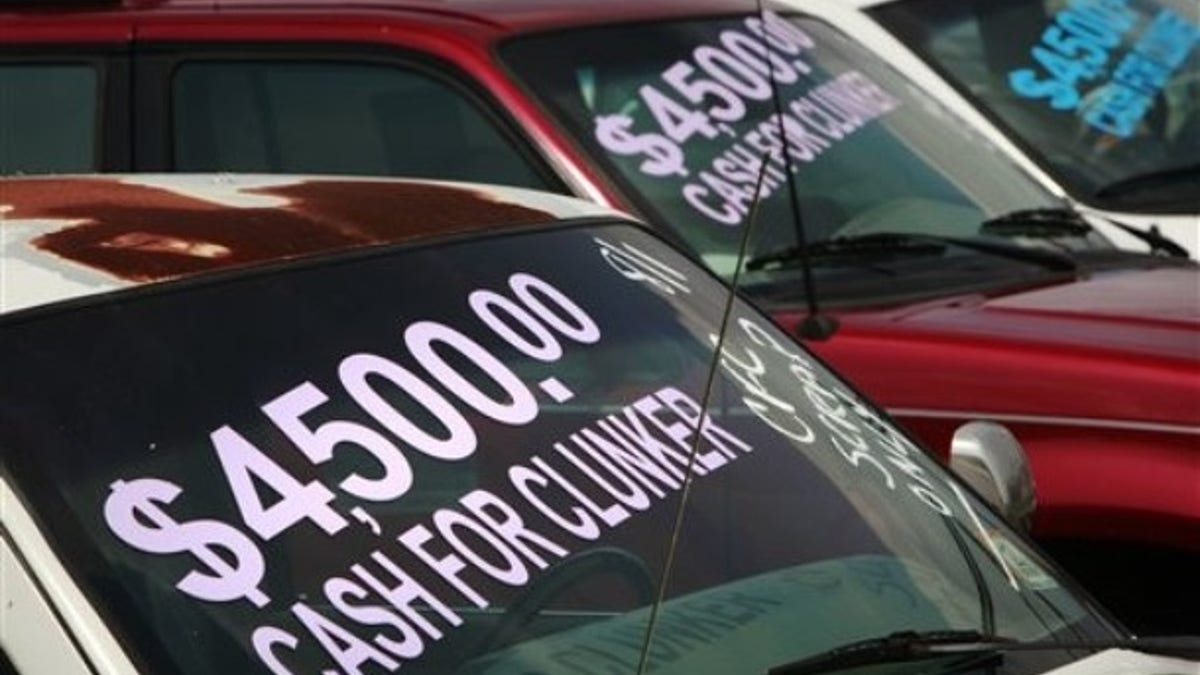
AP
Washington is busy patting itself on the back for the cash for clunkers program. Congress, meanwhile, is preparing to pour another $2 billion into the program. Spurred by government stimulus rebates of up to $4,500 per clunker, folks are rushing to car dealers to get a piece of the action. Yet, what no one in Washington is talking about is the actual cost to taxpayers of each clunker. Certainly, it's more than $4,500 per car.
Reading the C.A.R.S. "clunker" legislation, the program details reveal that a significant amount of the $1 billion program's funding is used by Department of Transportation (DOT) to administer the program.
First, DOT created and staffed an entirely new organization with three divisions to administer the clunkers program.
Second, the funding was allocated to cover extensive Help Desk telephonic support, promotional materials, mailers, travel, Web site development and maintenance. Plus, extensive administrative and managerial staffing was also funded. There is staffing to manage the contracts, to review the auto dealer submissions, to develop Executive Branch and Congressional reporting, and to provide investigatory oversight for the program.
Federal government staffing for 3 divisions doesn't come cheaply. Add to it other administrative and overhead costs for office space, telecommunications, power, equipment and furniture, as well as costs for meetings, photocopying, paper, pens, help desk support. When the government's costs of running the program are totaled up, each clunker is likely to cost taxpayers around $6,000 per car.
And there's more: A quick look just at staffing reveals staggering costs. The National Highway Traffic Safety Administration (NHTSA) was given approval to staff up for the completion of a series of four Forms connected with the program (Forms 1070, 1071, 1073 and 1075). Estimated staffing for these 4 reports was 160,353 man hours, or approximately 78 employees.
These 78 employees might be contracted out with a private sector vendor (which thepPresident has made clear is not a choice he prefers). Or, they may be pulled from existing projects, which increases the execution risks for those assignments (perhaps critical infrastructure?). Or, the government might hire new employees. At a fully loaded cost, including all compensation and benefits, that works out to approximately $150,000 per employee.
Even the most modest estimate means that DOT will have used approximately $12 million of the funds from the clunker program just to handle 4 of the forms for car dealers. Of course, there are many more forms connected with the clunker program. Get the picture?
Then there is the government's Help Desk Support, which is usually provided by the private sector and often funded on a per call basis. But, often minimum values are built into each contract, protecting the help desk provider, who must man the phones, regardless of calls received. If DOT uses an existing government vendor, contracts would still have to be modified to add funding and requirements for this new task, which requires the efforts of contracting officers, program managers and administrative support.
The administrative costs are huge on the record keeping side also. The law states that the records have to be kept for a period of five years, which would involve storage of hard copies and electronic media. One of the off-site record storage entities would need their government contract modified to add funding for this new task.
Clunker funding was used to develop the official Web site (www.cars.gov), but also, undoubtedly, the contract has an ongoing requirement to support the Web site and its transactions. The cost for the Recovery.gov Web site contract was approximately $18 million to upgrade and modify an existing Web site -- so, one can only imagine what the price tag is on a rush-job, creating a robust Web site, capable of handling millions of hits, as well as forms processing and data storage.
Add up all the various government costs of administrating the program and it will likely come to several hundred million dollars, which makes the true taxpayer cost of each clunker approximately $6,000.
In addition to the high costs comes tremendous execution risk in the Clunker program and the likelihood of fraud. Perhaps, one of the most disturbing parts of the Clunker program is that the recipient of the $4,500 doesn't need to provide a Social Security number. So, it is possible for illegal immigrants, as well as resourceful folks from Canada and Mexico, to cross our borders, trade in their clunkers, and get American taxpayer dollars. But don't expect anyone in Congress to admit that taxpayers are paying around $6,000 to provide a $4,500 rebate for a foreigner or illegal immigrant to buy a new car.
Before Congress allocates further funding to the "clunker" program, they should demand an audit of the full cost of the program. This time, Congress should insist upon learning the full administrative and overhead costs of DOT to run the program, with special consideration to the long term costs associated with federal employees to run a program of short duration. More interesting, still, would be an audit to determine how many non-American citizens are participating in the program. Once Americans get some transparency on those numbers, we will have a much better understanding of the clunker program and will be better able to determine its success.
When Americans find out just how much this program is costing, and where the benefits are going, watch the enthusiasm evaporate.
Lurita Doan is the former Administrator of the U.S. General Services Administration and commentator for Federal News Radio 1500AM.
